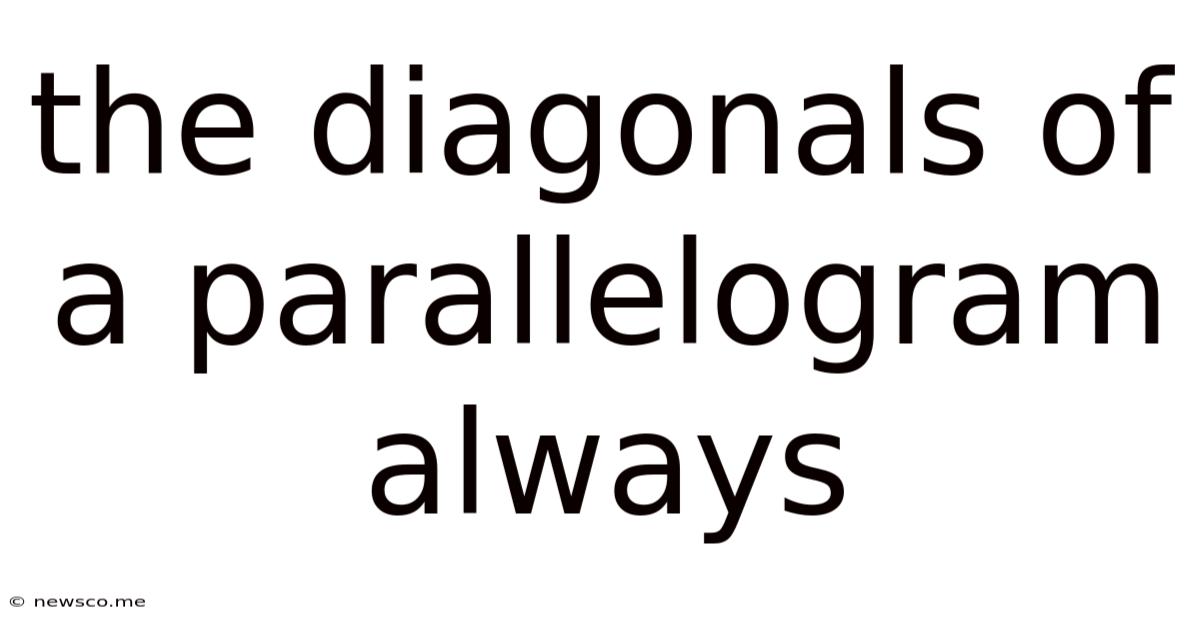The Diagonals Of A Parallelogram Always
News Co
Mar 20, 2025 · 5 min read

Table of Contents
The Diagonals of a Parallelogram: A Comprehensive Exploration
The humble parallelogram, a quadrilateral with opposite sides parallel, holds a fascinating geometric property within its diagonals. This article delves deep into the characteristics of parallelogram diagonals, exploring their properties, proving key theorems, and showcasing their applications in various mathematical contexts. We'll examine why the diagonals of a parallelogram always bisect each other, explore the conditions under which a parallelogram becomes a rectangle, rhombus, or square based on its diagonals, and consider advanced implications in higher-level mathematics.
Understanding the Parallelogram
Before diving into the specifics of its diagonals, let's solidify our understanding of a parallelogram. A parallelogram is defined by two pairs of parallel sides. This simple definition leads to several important consequences:
-
Opposite sides are equal in length: This arises directly from the parallel nature of the sides. Consider the parallelogram ABCD, where AB is parallel to CD and BC is parallel to AD. We can use congruent triangles formed by drawing a diagonal to prove that AB = CD and BC = AD.
-
Opposite angles are equal: Again, this is a consequence of parallel lines and alternate interior angles. Angle A is equal to Angle C, and Angle B is equal to Angle D.
-
Consecutive angles are supplementary: The sum of consecutive angles (e.g., Angle A + Angle B) equals 180 degrees. This follows from the properties of parallel lines and interior angles.
The Crucial Property: Diagonals Bisect Each Other
The most fundamental property of parallelogram diagonals is that they always bisect each other. This means that the point where the diagonals intersect divides each diagonal into two equal segments.
Theorem: The diagonals of a parallelogram bisect each other.
Proof: Let's consider parallelogram ABCD with diagonals AC and BD intersecting at point O.
-
Consider triangles ΔABO and ΔCDO: Since AB is parallel to CD, and lines AC and BD are transversals, we have ∠BAO = ∠DCO (alternate interior angles) and ∠ABO = ∠CDO (alternate interior angles). Furthermore, AB = CD (opposite sides of a parallelogram are equal). Therefore, by the Angle-Side-Angle (ASA) congruence theorem, ΔABO ≅ ΔCDO.
-
Congruent Triangles Imply Equal Sides: Because the triangles are congruent, their corresponding sides are equal. Specifically, AO = CO and BO = DO. This proves that the diagonals bisect each other.
Beyond the Basic: Parallelograms and their Special Cases
The properties of the diagonals can help us classify different types of parallelograms:
Rectangles
A rectangle is a parallelogram where all angles are right angles (90 degrees). In a rectangle, the diagonals are not only bisected but are also equal in length. This is easily proven using the Pythagorean theorem on the right-angled triangles formed by the diagonals and sides.
Rhombuses
A rhombus is a parallelogram where all sides are equal in length. In a rhombus, the diagonals are perpendicular bisectors of each other. This means they intersect at a right angle and each diagonal divides the rhombus into two congruent isosceles triangles. This perpendicularity can be proven using congruent triangles and properties of isosceles triangles.
Squares
A square is both a rectangle and a rhombus. Therefore, a square possesses all the diagonal properties of both: the diagonals are equal in length, bisect each other, and are perpendicular bisectors.
Applications and Advanced Concepts
The properties of parallelogram diagonals extend beyond basic geometry and find applications in various areas:
-
Vector Geometry: Parallelograms and their diagonals are fundamental in understanding vector addition and subtraction. The diagonal represents the resultant vector when two vectors are added.
-
Coordinate Geometry: The midpoint formula and distance formula can be used to verify the properties of parallelogram diagonals when coordinates of the vertices are given.
-
Proofs and Problem Solving: Understanding parallelogram diagonal properties is crucial for solving various geometry problems involving proving congruency, finding lengths, and determining angles.
-
Linear Algebra: The concept of linear independence and spanning sets is closely related to the properties of parallelograms in higher dimensions.
Proving Parallelograms Based on Diagonals
Conversely, we can use the properties of diagonals to prove that a quadrilateral is a parallelogram. If we can demonstrate that the diagonals of a quadrilateral bisect each other, then we have proven that the quadrilateral is a parallelogram. This provides an alternative method of parallelogram identification.
Advanced Theorems and Extensions
The exploration of parallelogram diagonals can lead to more advanced geometric theorems. For example, consider the relationship between the areas of triangles formed by the diagonals within a parallelogram. These areas can be proven to be equal, providing another avenue for problem-solving.
Furthermore, the concepts extend to higher-dimensional analogues of parallelograms, such as parallelepipeds in three dimensions. The properties of their spatial diagonals are analogous but more complex to visualize and prove.
Conclusion: The Significance of Parallelogram Diagonals
The diagonals of a parallelogram are far more than just lines connecting opposite vertices. They represent a fundamental geometric property that dictates the characteristics of the parallelogram and its special cases. Understanding their properties is crucial for mastering various geometric concepts, solving problems, and extending knowledge into more advanced mathematical fields. From basic proofs to applications in vector geometry and linear algebra, the diagonals of a parallelogram offer a rich and rewarding area of study for mathematicians of all levels. Their consistent and predictable behavior makes them a cornerstone of geometric understanding. By thoroughly grasping these properties, a solid foundation for more advanced geometric explorations is established. The seemingly simple parallelogram, therefore, reveals a wealth of mathematical insights through the careful examination of its diagonals.
Latest Posts
Related Post
Thank you for visiting our website which covers about The Diagonals Of A Parallelogram Always . We hope the information provided has been useful to you. Feel free to contact us if you have any questions or need further assistance. See you next time and don't miss to bookmark.